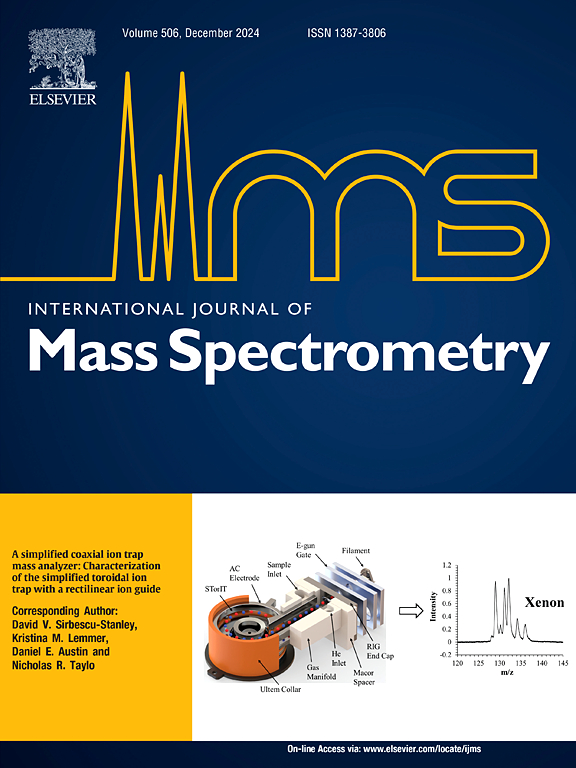Dehydrogenation of formic acid by first-row transition-metal/crown ether complexes studied by mass spectrometry and theoretical calculations
IF 1.7
3区 化学
Q3 PHYSICS, ATOMIC, MOLECULAR & CHEMICAL
引用次数: 0
Abstract
We have investigated ternary cationic complexes of several first-row transition metals M2+ (M = Mn, Fe, Co, Ni, Cu and Zn) with three crown ethers L (where L = 12-crown-4, 15-crown-5, and 18-crown-6) with the goal of hydrogen production from formic acid. The ions of the general formula [LM(OOCH)]+ can be easily formed by electrospray ionization and decarboxylated in the gas phase via collision-induced dissociation (CID) with virtually no side reactions to form the corresponding hydride complexes [LMH]+. These hydride complexes were reacted with the neutral formic acid via a gas-phase ion-molecule reaction in the linear quadrupole ion trap which resulted in the production of the molecular hydrogen and re-formation of the initial [LM(OOCH)]+ ion. Thus, the process represented a formal catalytic cycle with the overall equation HCOOH = H2+ CO2. The experimental collision efficiencies of these reactions for 12-crown-4 complexes ranged from 0.2 % (Zn) to 100 %(Co) and followed the trend Co ≥ Ni ≥ Mn > Fe > Cu ≫ Zn. These results correlate very well with the theoretical DFT calculations for the transition state energies (barriers). Additional theoretical calculations looked at the structure of the complexes for the explanation of the observed trends. It was shown for Zn complexes that bigger crowns, especially 18-crown-6, can be significantly distorted resulting in one of O-Zn bonds being significantly shorter than the others. The work shows that crown ethers can serve as effective, flexible ligands for dehydrogenation of formic acid by first-row transition metal ions.

用质谱法和理论计算研究了第一排过渡金属/冠醚配合物对甲酸脱氢的影响
我们研究了几种第一排过渡金属M2+ (M = Mn, Fe, Co, Ni, Cu和Zn)与三冠醚L(其中L = 12-冠- 4,15 -冠-5和18-冠-6)的三元阳离子配合物,目的是从甲酸中产氢。通式[LM(OOCH)]+离子可以很容易地通过电喷雾电离形成,并在气相中通过碰撞诱导解离(CID)脱羧基,几乎没有副反应形成相应的氢化物配合物[LMH]+。这些氢化物配合物在线性四极离子阱中通过气相离子-分子反应与中性甲酸反应,产生分子氢并重新形成初始的[LM(OOCH)]+离子。因此,该过程代表了一个形式的催化循环,其总体方程为HCOOH = H2+ CO2。12-冠-4配合物的实验碰撞效率在0.2% (Zn) ~ 100% (Co)之间,并遵循Co≥Ni≥Mn >的规律;菲比;Cu ^ Zn。这些结果与跃迁态能量(势垒)的理论DFT计算非常吻合。额外的理论计算着眼于复合物的结构,以解释观察到的趋势。结果表明,对于锌配合物,较大的冠,特别是18冠-6,会导致O-Zn键明显短于其他键。研究表明,冠醚可以作为一种有效的柔性配体,用于第一排过渡金属离子对甲酸脱氢。
本文章由计算机程序翻译,如有差异,请以英文原文为准。
求助全文
约1分钟内获得全文
求助全文
来源期刊
CiteScore
3.60
自引率
5.60%
发文量
145
审稿时长
71 days
期刊介绍:
The journal invites papers that advance the field of mass spectrometry by exploring fundamental aspects of ion processes using both the experimental and theoretical approaches, developing new instrumentation and experimental strategies for chemical analysis using mass spectrometry, developing new computational strategies for data interpretation and integration, reporting new applications of mass spectrometry and hyphenated techniques in biology, chemistry, geology, and physics.
Papers, in which standard mass spectrometry techniques are used for analysis will not be considered.
IJMS publishes full-length articles, short communications, reviews, and feature articles including young scientist features.

 求助内容:
求助内容: 应助结果提醒方式:
应助结果提醒方式:


